News & Blogs
In this blog, we touch on diverse topics about Japanese food cultures, practices together with the culinary secret, TREHA®, and its important role in the Japanese food industry. We hope our blog helps you obtain in-depth knowledge of the secrets and science behind Japanese cuisine, shared from our kitchen, to yours.
This article is dedicated to the late Sensei S. T. who taught me not only the formalities but also the true sense of hospitality and respect to others through the Japanese tea ceremony. I feel genuinely grateful and fortunate that he guided me through the world of this ancient Japanese tradition since the first day I stepped into it. Although a decade has passed since he left this world, a feeling of remorse occurs to me because I was not able to reciprocate him for the most valuable life lesson I received while he was present. I am hoping to express the deepest gratitude to my most admired sensei by sharing what he had taught me with the world.
Remember the simple rules to drink matcha; forget about all other details.
The wait is finally over. We enter the tea room. You’re welcome to copy me. If this is a formal tea gathering, we are supposed to appreciate the décor in the room, including a hanging scroll, flower arrangement in the alcove, and tea utensils such as a kettle and vessel. Since many guests participated in this casual tea gathering, we omit this ritual and get seated in order. Please rest assured that we can take a close look at those attractive items after the ceremony.
The guest seated at the upper seat is “the main guest,” called "shokyaku (正客 the main host),” who must carry on a conversation with the host to represent all other guests in the room. The main guest’s mission is to inform the ceremony's theme and items suited to the theme that everyone might be interested in learning. The energy in the tea room can be significantly influenced by the conversation between the host and the main guest. Since this is your debut, let’s get situated after the main guest to observe how the conversation goes. For your information, even when an experienced main guest is not available, the host would fill in the absence by sharing stories the quests might be interested in, exhibiting the hospitality spirit to liven up the gathering.
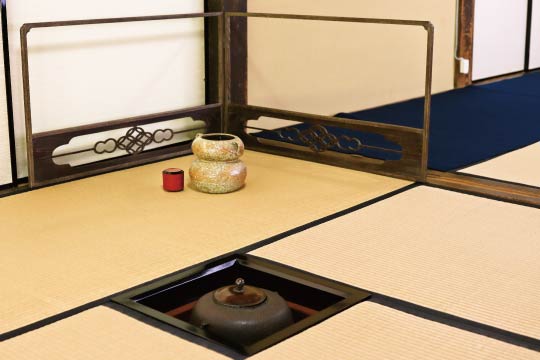
Well, it seems like the guests are all seated now. The Shokyaku (正客) is greeting and letting other guests know that she is honored to be the main guest of the ceremony. Let’s bow and thank her for taking this demanding role. The tea room falls utterly silent, making us feel pleasant tension in the air. The sliding door leading to the “backstage” is now open. The hosting staff informed us that we would be receiving sweets. Let’s greet back to the team.
All guests receive sweets, the sliding door is closed, and the room is surrounded by silence again. Please wait for a little longer before helping yourself with the sweet, however enticing it seems. Also, if you are having a hard time sitting upright, you can relax your legs and sit comfortably until the staff comes in once more.
Here comes the tea preparer, walking through the sliding door to greet us, carrying in tea bowls and various utensils. (Please be patient with sitting upright for a little while!) Finally, the host enters the room and greets the main guest. Let's chime for the greeting session.
Now we are encouraged to enjoy the desserts. From this time on, except when receiving tea and exchanging closing greetings, it is okay not to sit upright. Make yourself comfortable! Tune in on the informative conversation between the host and the main guest. You will be surprised how many stories each item in this small tea room can tell. Usually, the explanation starts with items displayed in the alcove. The alcove is decorated commonly with flower arrangements and hanging scrolls.
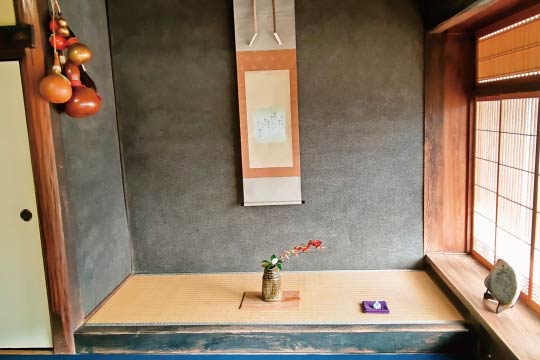
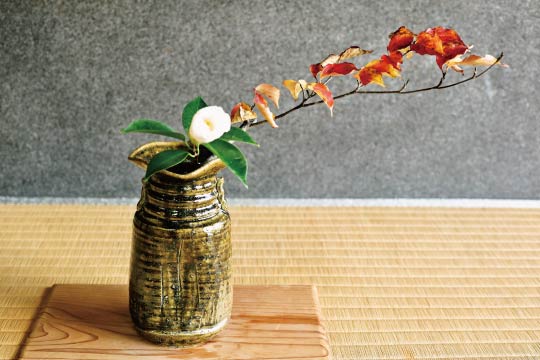
Today's hanging scroll is a Tanka poetry created in Takahashi City 20 years ago by Sojitsu Kobori, the 13th grand tea master (Iemoto) of the Enshu School. The flower arrangement consists of white camellia and Japanese dogwood branches whose leaves have turned red. The flower vase is Shitoro ware and was created by Rito Honda.
Meanwhile, the staff is seamlessly preparing matcha in the following steps:
Bring out the utensils needed to prepare tea and set them in front of guests.
Clean those utensils and place them in proper tea-preparing position.
Prepare tea swiftly and efficiently and serve it to the guests.
Once the tea is served to all guests, the utensils are returned to the original set position.
Bring back utensils to finish the ceremony.
While the conversation continues between the host and the main guest, a bowl of tea for the main guest is prepared right in front of the eyes of all the guests. The main guest takes a sip of the tea and complements the taste. Right after that, the preparer starts working in another bowl of tea. You may be worried if you end up spending a lifetime before receiving the tea. Don’t worry. At a casual tea gathering like this, only the main guests and the second guest receive the tea prepared in the tea room. The rest of the guests receive tea prepared in the backroom for efficiency.
Our matcha is here! If you were slouching, correct your posture to receive the tea. Although they vary depending on the school, various rules and manners exist for drinking matcha. Your takeaway of the day is the three most important ones.
Rule #1: Avoid drinking tea from the front of the bowl. When you receive the bowl, the side facing you is the front where the bowl looks most presentable. Turn the bowl a little off-center so that you would not ruin the design or style with a stain. How is the taste? I bet the sweetness from the treat remaining in your mouth enhances the taste of green tea. Enjoy the exquisite complexity developed by the sweetness, umami, and bittersweet taste of matcha.
Rule #2: Clean the part where you put your lips with your index finger and thumb after finishing the tea. Wipe your fingers with a sheet of kaishi washi paper.
Rule #3: Turn back the front of the bowl to the center when you return the bowl. Done!
Even though the details of turning the bowl vary by the tea school, you should feel comfortable if you know the three basic rules.
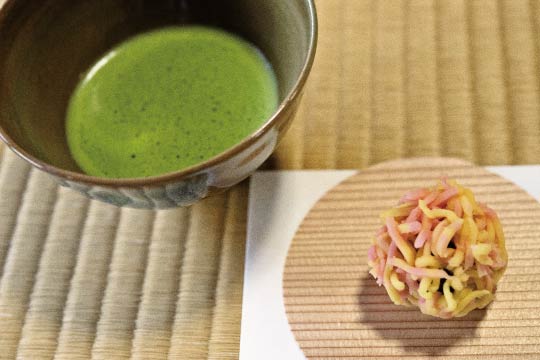
Now that all the guests receive the tea, the clean-up sequence is quietly initiated. While all the tea utensils are orderly put away, the tea container and the tea scoop are often left in the room for the guests to appreciate later. In addition, the bowls used for the main and second guests are displayed after being cleaned as they are symbolic items for the gathering.
Fun time goes by so fast. The gathering is now concluded by greeting the host and the main guest. When leaving the tea room, take a closer look to appreciate the scroll, flowers in the alcove, and tea utensils. Don’t forget to check out the kettle, since we didn’t have a chance before.
Let's have dim sum, another fun part of the tea gathering.
Since there are multiple tea ceremonies in the same venue, participating in another event is doable. Still, I suggest having “ten shin (点心)” to enjoy the afterglow of the previous ceremony.
“Ten shin” is the Japanese pronunciation of Chinese "dim sum,” which may be familiar to everyone. Like the one in Chinese cuisine, it also refers to the light meal accompanied by tea. Dim sum was introduced to Japan with the tea-drinking custom by monks who studied in China around the 13th century. Today's dim sum is sushi rolls! Why don’t we enjoy them while looking at the view of the beautiful garden? Now, this is true bliss!
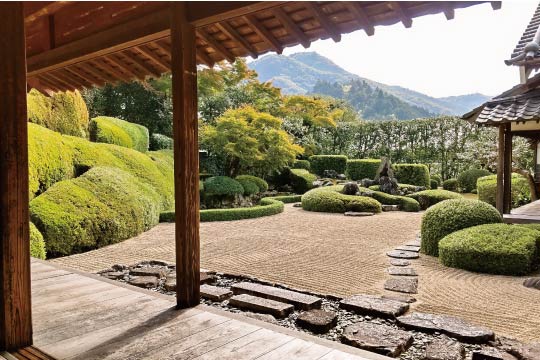
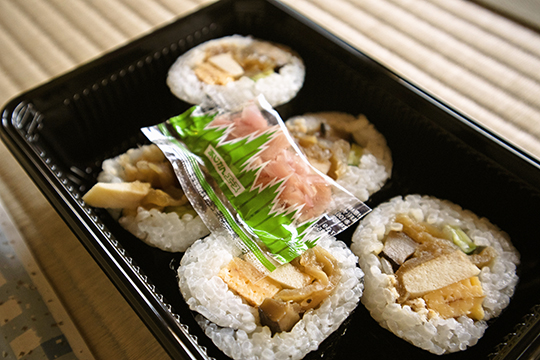
After a memorable ceremony and equally memorable dim sum snack, are you ready to join another ceremony hosted by the Urasenke School? They appear using chairs and tables to perform ryurei (立礼 table seated) style, so there is no need to worry about our legs getting numb.
It is a half-day event on a beautiful day in the fall. How do you like it? If you have a chance, please join oyose chakai (大寄せ茶会), the casual tea gathering to get a glimpse of tea ceremony treasured by the Japanese for centuries.
Did you find this blog interesting?
Please share it with your friends in the food service industry.
We regularly update the blog about the food culture of Japan, where TREHA® was discovered for culinary applications.
Click here and send us a message to subscribe.
Or hit us up on Instagram @trehalose_sensei!
You might also be interested in:

